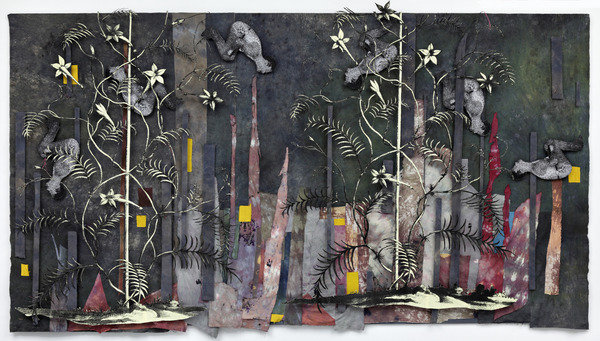Kirstine Roepstorff
dal 22/10/2010 al 29/1/2010
Segnalato da
Christian Selz - Museum fur Gegenwartskunst
22/10/2010
Kirstine Roepstorff
Kunstmuseum Basel, Basel
Dried Dew Drops: Wunderkammer of Formlessness. The works of Danish artist are based on the principles of collage. They range from small, intimate works on paper to large-scale, theatrical installations and draw upon a wide spectrum of source material and reference systems. Roepstorff's Wunderkammer focuses on certain artefacts that it transforms into figures in her personal cosmos. It features vases and amphora from ancient Greece, a necklace made of animal bones, or a ritual apparatus from the Ming-Dynasty.

The works of Danish artist Kirstine Roepstorff (born 1972 in Virum, lives and works in Berlin) are based
on the principles of collage. They range from small, intimate works on paper to large-scale, theatrical
installations and draw upon a wide spectrum of source material and reference systems. She uses
images and texts from news reports, magazines, historical material, and advertisements, incorporating
them into her own work and ultimately arranging them through a process of copying, scaling, cutting
out, and ordering to form astonishing new pictures. In her own words: “I use the method of collage to
appropriate and rearrange the already existing world.” This technique is something that Roepstorff has
come to describe as a process of “appropriarranging”.
Alongside Roepstorff’s works, the exhibition presents a Wunderkammer containing an astonishing
selection of objects and curiosities from world-renowned collections. This unique show reflects
Roepstorff’s particular method of working – where images and ideas can be viewed differently through
their specific juxtapositions. This Wunderkammer encompasses a diversity of artefacts from natural
history, the history of medicine, geology, ethnography, and fine-art, ranging from ancient religious relics
to works of modern and contemporary art. The Wunderkammer presents spaces with differing dyna-
mics, spaces in which we encounter objects that serve as sources of inspiration for Roepstorff’s works
– a microcosmic world of wondrous things to which different forms of relational systems are attributed.
Roepstorff’s Wunderkammer focuses on certain artefacts that it transforms into figures in her personal
cosmos. It features vases and amphora from ancient Greece, a necklace made of animal bones, or a
ritual apparatus from the Ming-Dynasty. A deity of a mother and her infants (75 – 150 AD), a helmet
from the Roman Empire (3rd. – 1st. century BC), assembled from large shells, refers to ritual
relationships. Among the objects that one would expect to find in every Wunderkammer are fossilized
sharks’ teeth, preserved animal specimens, including scorpions, a blowfish, a snake, a crocodile,
muscles, corals, butterflies and various insects.
With loans and generous support, the following museums and collections were crucial to the realization
of the Wunderkammer: Museum der Kulturen, Antikenmuseum and Sammlung Ludwig, Pharmazie-
Historisches Museum, Naturhistorisches Museum (all in Basel), Museum zu Allerheiligen in
Schaffhausen. Our thanks go to all the individuals from these institutions for a unique and productive
collaboration – allowing us access to their many treasures that in some cases have been tucked away
quietly in storage for some time now.
Sponsor: Fonds für künstlerische Aktivitäten im Museum für Gegenwartskunst der Emanuel Hoffmann-
Stiftung und der Christoph Merian Stiftung.
Further support: Danish Arts Council, Committee for International Visual Art;
Kvadrat A/S; J. Bollig AG, Basel, Wilfried Heiber GmbH, Basel; Internationale Künstlerinnenstiftung –
Die Höge, Hamburg
Press Office: Christian Selz, Tel. 0041 (0) 61 206 62 06
pressoffice@kunstmuseumbasel.ch
Opening 23 October 2010
Museum für Gegenwartskunst
St. Alban-Rheinweg 60, CH-4010 Basel
Hours: Tue-Sun 11-18 Uhr



